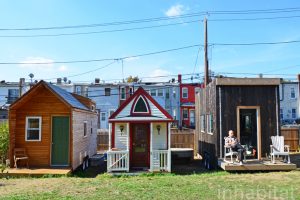Have you ever been to a doctor who insists on treating you for one problem when you know in your heart that it’s really something else? No matter what you do, you cannot get the doctor to investigate anything but the problem he has identified. It only resolves itself by changing doctors.
 Construction set to begin on 240-unit affordable housing complex in Bend
Construction set to begin on 240-unit affordable housing complex in Bend
Bend City, Oregon, one of the state’s fastest-growing communities, has announced that it has approved $1.3 million that will go toward three new “affordable housing” developments to create “400 units of affordable housing.” As OPB.org says, “the city “doesn’t have enough available housing, particularly for low-and middle-income people.” One of the approved units will offer rentals to people making between $50,000 and $80,000. (The very fact that $80,000 is considered “low income” here should be a red flag). One of these, Central Oregon Veterans Village, will include “tiny homes” with a bed, table and chairs, bathroom, and closet with, apparently, communal showers and dining. Bend also purchased a motel, the Old Mill & Suites, for “transitional housing.”
Bend, Oregon isn’t alone. The Santa Clara County Board of Supervisors has Bend beat by a factor of 100, approving $100 million in permanent housing for low-income residents (566 units to house 2,100 people). This came as part of a $1 billion housing measure in 2016 that was to provide “affordable housing projects” with a goal toward building 4,800 “affordable units” by 2028. Santa Clara has about 10,000 homeless, or, as the new woke catchphrase is, “unhoused people.”
Last July, the mayor of Phoenix, Arizona, announced an “affordable housing plan. “This plan had as a goal 50,000 “affordable” units by 2030 by prioritizing “new housing in areas of opportunity,” amending zoning, redeveloping city-owned land, enhancing public-private partnerships (i.e., bribing builders), and supporting affordable housing legislation. In Maryland, the Hogan administration announced its “Affordable Rental Housing Awards,” which has, the administration bragged, created 20,000 rental units across the state. Detroit announced five new “affordable” housing projects in October 2020.
 It’s interesting that liberals have returned to the term “the projects,” for that was exactly what Cabrini Green and other such monstrosities of public welfare were called in the 1940s and 1950s in what was called at the time “urban renewal” (but referred to by blacks as “Negro Removal”). Sociologist Charles Murray, in his path-breaking book Losing Ground, argued that the Great Society welfare programs disproportionately harmed blacks precisely because so many were congregated in public housing or Cabrini Green type projects that, unlike rural whites who were scattered about, welfare agents could sign up large numbers of residents for welfare in one fell swoop.
It’s interesting that liberals have returned to the term “the projects,” for that was exactly what Cabrini Green and other such monstrosities of public welfare were called in the 1940s and 1950s in what was called at the time “urban renewal” (but referred to by blacks as “Negro Removal”). Sociologist Charles Murray, in his path-breaking book Losing Ground, argued that the Great Society welfare programs disproportionately harmed blacks precisely because so many were congregated in public housing or Cabrini Green type projects that, unlike rural whites who were scattered about, welfare agents could sign up large numbers of residents for welfare in one fell swoop.
There are, unfortunately, two realities about “unhoused people"; these are largely unrelated, and each must be dealt with to “solve” the crisis of the homeless. First, in many of today’s communities (Bend, Santa Clara, Austin), the tech industries have created a structure of exceptionally and, in the near future, unstoppable high salaries. The median income in Silicon Valley is $110,000, meaning half of the incomes are above that. In San Francisco, as of 2018, the average household made double that of the national median household income.
In 2018 in Silicon Valley, the median-priced home was $1.18 million—again, meaning that half of the homes there are above $1.18 million. Let’s think about that: a 30-year mortgage on such an “average” home at 4% is $4,770. According to “Mortgage Reports,” if you have great credit, low debts, and big savings, you might afford such a mortgage on an income of $100,000 a year. But higher debt, less savings? Peter Warden of “Mortgage Reports” estimates you would need an income of over $225,000 a year. Some software engineers and computer geeks might make this. Most won’t. And most people will have significant other debts—cars, credit cards, and medical bills.
 How about police, firefighters, secretaries, trash collectors, teachers, dry cleaners, grocery store managers, small business owners of all kinds? Do you think they will be pulling down $225,000—especially in high tax areas such as Silicon Valley, San Francisco, Chicago, New York, or Austin? So, the first issue of the “homeless” is to figure out how to keep the middle class from being homeless in the first place. As early as 2002, the Millennial Housing Commission warned that “more Americans are finding it impossible to find affordable housing.” Simply building units, however, does not provide an answer. What has developed are makeshift policies to provide band-aids to the open wounds. For example, at Chapman University in Orange, California, an assistant professor job opening went unfilled for years because even at a salary well outside the norm for an assistant professor, no young academic could even begin to buy a house in Orange or its surrounding regions. The University’s solution? Have the University buy housing and rent it out—which is fine unless people do not want to be renters (as should be the case most of the time. Rent doesn’t ever create wealth in the form of equity). In parts of California, a one- to two-hour one-way commute is the norm for many in the middle class, service, or self-employed business sectors.
How about police, firefighters, secretaries, trash collectors, teachers, dry cleaners, grocery store managers, small business owners of all kinds? Do you think they will be pulling down $225,000—especially in high tax areas such as Silicon Valley, San Francisco, Chicago, New York, or Austin? So, the first issue of the “homeless” is to figure out how to keep the middle class from being homeless in the first place. As early as 2002, the Millennial Housing Commission warned that “more Americans are finding it impossible to find affordable housing.” Simply building units, however, does not provide an answer. What has developed are makeshift policies to provide band-aids to the open wounds. For example, at Chapman University in Orange, California, an assistant professor job opening went unfilled for years because even at a salary well outside the norm for an assistant professor, no young academic could even begin to buy a house in Orange or its surrounding regions. The University’s solution? Have the University buy housing and rent it out—which is fine unless people do not want to be renters (as should be the case most of the time. Rent doesn’t ever create wealth in the form of equity). In parts of California, a one- to two-hour one-way commute is the norm for many in the middle class, service, or self-employed business sectors.
 At what point, then, do the techies with their high salaries price everyone else out of the housing market? And how do new “tiny” government-engineered “units” even remotely address this issue? The answer is, “we don’t know yet.” For whatever reason, people have willingly tolerated ridiculously high mortgage payments and ludicrously long commutes to live in or near decaying urban centers. Maybe the China Virus will change that. Already landlords are dropping rents in San Francisco at shocking levels. Remote work is proving to be the death knell of some of the big tech urban areas, which are starting (finally) to be depopulated. This would be a start toward “fixing” the homeless issue.
At what point, then, do the techies with their high salaries price everyone else out of the housing market? And how do new “tiny” government-engineered “units” even remotely address this issue? The answer is, “we don’t know yet.” For whatever reason, people have willingly tolerated ridiculously high mortgage payments and ludicrously long commutes to live in or near decaying urban centers. Maybe the China Virus will change that. Already landlords are dropping rents in San Francisco at shocking levels. Remote work is proving to be the death knell of some of the big tech urban areas, which are starting (finally) to be depopulated. This would be a start toward “fixing” the homeless issue.
The second factor has been with us for decades and is the elephant in the room. Mental illness and drug abuse (often they go hand-in-hand) have led to a large class of homeless people who do not want a “home,” don’t want to rent, don’t want any of the structures or limitations that they see in “traditional” life.  All the “tiny homes” in the world will not address their mental conditions in the slightest. In 1975, the U.S. Supreme Court ruled in O’Connor v. Donaldson that a mentally ill person had to be a danger to himself or others to warrant confinement. Thus, the asylums disgorged thousands of crazy people onto the streets. Typically, the New York Times, while admitted the experiment was a massive failure, blamed lack of funding for clinics. This was equivalent to telling a drunk not to drive: he’s drunk, you idiot! He doesn’t process information logically or ethically.
All the “tiny homes” in the world will not address their mental conditions in the slightest. In 1975, the U.S. Supreme Court ruled in O’Connor v. Donaldson that a mentally ill person had to be a danger to himself or others to warrant confinement. Thus, the asylums disgorged thousands of crazy people onto the streets. Typically, the New York Times, while admitted the experiment was a massive failure, blamed lack of funding for clinics. This was equivalent to telling a drunk not to drive: he’s drunk, you idiot! He doesn’t process information logically or ethically.
In short, neither of the factors contributing to the majority of modern-day homelessness is addressed in any way, shape, or form by new “affordable housing” initiatives. One is entirely attitudinal: until people find the allure of living on a shoestring in locations such as Oregon, California, or urban areas like Austin or Minneapolis-St. Paul, we will constantly have an “affordability” crisis. Every new person moving-in drives prices up just that much more. Until police, teachers, administrators, and small business owners say “enough” and leave the elites with their high salaries and no one willing to protect them, teach their kids, do their cooking and cleaning, or fix their cars; there will be an “affordability” problem in all of these areas.
At the same time, until American society realizes that by being mentally ill—and homeless—an entire class is indeed a danger to others (through rampant destruction of property, threats to safety and life, and via disease)—and changes its laws, the second promise of “affordable” housing will remain an equally fantastic myth.



